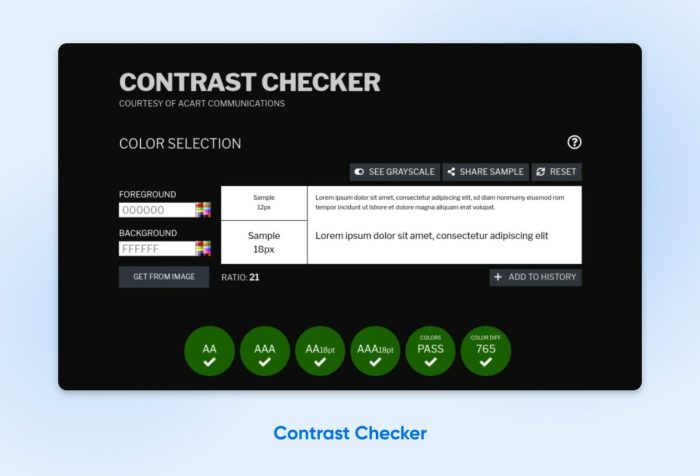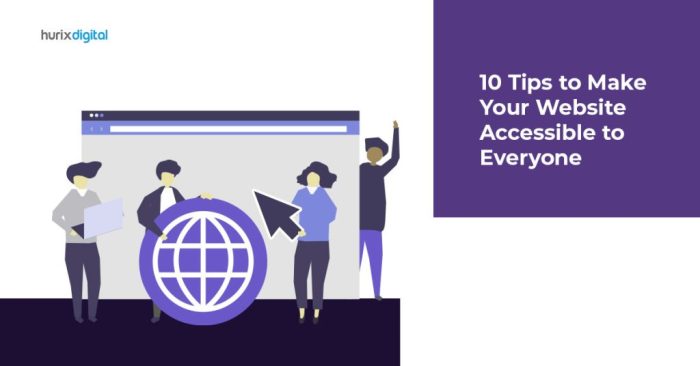How to make your website accessible is crucial for inclusivity and reaching a wider audience. This guide dives deep into the principles, practices, and tools needed to create websites that are usable by everyone, regardless of ability. From understanding the basics of accessibility to implementing practical strategies and evaluating your progress, we’ll cover everything you need to know.
We’ll explore the key principles of WCAG, different types of disabilities and their implications for design, and practical techniques for making your website usable. We’ll also discuss testing and evaluation methods, providing a complete toolkit for building accessible websites.
Introduction to Website Accessibility
Website accessibility is the practice of designing websites and digital resources so that people with disabilities can use them effectively and efficiently. This means ensuring that the content, navigation, and overall user experience are usable by a wide range of individuals, regardless of their physical or cognitive abilities. Accessibility isn’t just about compliance with regulations; it’s about creating a more inclusive and equitable digital world for everyone.Accessibility is crucial for fostering inclusivity and removing barriers for diverse users.
A website designed with accessibility in mind can be used by people with visual impairments, hearing impairments, motor impairments, cognitive impairments, and many other conditions. It also benefits users with temporary disabilities, such as injuries or illnesses, and users with varying levels of technical proficiency. By considering the needs of all users, we can create a more accessible and user-friendly digital environment for everyone.
Importance of Website Accessibility for Diverse Users
Accessibility benefits a wide range of users. A website designed for accessibility is usable by people with various impairments, ensuring equal opportunities for everyone to access and engage with online content. Users with visual impairments can access content using screen readers, while users with hearing impairments can benefit from captions and transcripts. Motor impairments are accommodated by keyboard navigation and large clickable elements, while cognitive impairments are addressed by clear and concise language, predictable layouts, and visual aids.
These considerations benefit everyone, even those without disabilities, as they create a more usable and intuitive website for everyone.
Benefits of Creating an Accessible Website
Creating an accessible website brings numerous advantages. It fosters a more inclusive online environment, welcoming people with disabilities and promoting equal access to information and services. Accessible websites are more user-friendly for everyone, increasing usability for users with varying technical skills and situations. This broadens your audience and increases potential customers. Furthermore, accessible websites can improve search engine optimization (), as search engines often prioritize accessible websites.
These benefits extend to legal and ethical considerations, improving your reputation as a responsible and ethical organization.
Legal and Ethical Considerations
Website accessibility is increasingly governed by legal requirements and ethical considerations. Many jurisdictions have laws mandating website accessibility, aiming to ensure equal access to information and services for all citizens. Ethical considerations go beyond legal requirements, emphasizing the importance of creating a truly inclusive and equitable digital experience for all users. Ignoring accessibility standards can lead to legal issues and damage a company’s reputation.
Types of Disabilities and Their Implications for Website Design
| Disability Type | Potential Website Challenges | Possible Solutions |
|---|---|---|
| Visual Impairment | Difficulty reading text, navigating visually, relying on screen readers | Use of alt text for images, sufficient color contrast, keyboard navigation, text alternatives for non-text content, proper heading structure |
| Hearing Impairment | Difficulty understanding audio content, difficulty following conversations | Provide captions and transcripts for audio and video, use visual cues for audio cues, provide alternative text for audio cues |
| Motor Impairment | Difficulty interacting with the website, using a mouse or trackpad | Keyboard navigation, large clickable elements, avoiding small interactive elements, providing adequate time for interaction |
| Cognitive Impairment | Difficulty understanding complex information, following complex navigation | Clear and concise language, visual aids, predictable layout, avoiding complex visual design, simple and intuitive navigation |
This table highlights the varying challenges different types of disabilities pose to website users and offers practical solutions for addressing these challenges. Understanding these needs allows website designers to create more inclusive and equitable digital experiences.
Key Principles of Accessibility
Building an accessible website isn’t just about being nice; it’s about ensuring everyone can use it. The Web Content Accessibility Guidelines (WCAG) provide a framework for creating websites that are usable by people with diverse abilities, including those with visual, auditory, motor, cognitive, language, and neurological differences. Adhering to these guidelines makes your website more inclusive and ultimately, more successful.The WCAG principles are not just a list of rules; they represent a holistic approach to design.
They are built upon four fundamental principles: perceivable, operable, understandable, and robust. By understanding and applying these principles, you can craft a website that is accessible to a broader audience, promoting equity and inclusivity online.
Making your website accessible is crucial for a broad audience. Think about how you’d want to navigate a site if you had limited vision or mobility. Understanding how to calculate market share, how to calculate market share , can actually help with this. By considering the demographics and needs of a diverse audience when designing your website, you’ll be building a more inclusive and user-friendly platform, making it accessible to everyone.
WCAG Principles and Conformance Levels
The WCAG principles are designed to be applied in a hierarchical manner, allowing for different levels of conformance. These levels, A, AA, and AAA, reflect the degree of accessibility. Level A is the minimum standard, AA is the generally recommended level, and AAA is the most stringent, aiming for the most comprehensive accessibility. Understanding the different levels helps prioritize accessibility efforts and ensure your website meets the needs of your users.
Perceivable Content
Ensuring perceivable content involves making sure all information is presented in ways that users can perceive. This includes providing text alternatives for non-text content, using captions and transcripts for audio and video, and employing sufficient color contrast. Users with visual impairments, for instance, rely on screen readers to access website content, so clear text alternatives are crucial.
Operable User Interface
An operable user interface is crucial for users with physical limitations. This involves providing sufficient time for users to interact with the content, allowing users to operate content using keyboard navigation, and avoiding content that causes seizures. A user should be able to navigate through the website efficiently, without needing specific devices or advanced knowledge.
Understandable Information and Design
Creating understandable information and design is about making content clear and predictable for all users. This includes using clear and concise language, providing context for complex information, and avoiding the use of jargon. Clear and organized layouts, along with helpful instructions, ensure users with varying levels of technical expertise can comprehend the content.
Robust Content for Assistive Technologies
Robust content ensures that assistive technologies can accurately interpret and render the content. This includes using semantic HTML and avoiding the use of technologies that may not be interpreted correctly by screen readers. By using appropriate HTML tags and avoiding non-standard approaches, you help assistive technologies interpret the information correctly, creating a better user experience for people who rely on them.
Creating Accessible User Interfaces for Physical Impairments
Designing user interfaces that cater to people with various physical impairments involves considering a wide range of needs. This includes using keyboard navigation as a primary method of interaction, designing for touchscreens, and providing options for users with limited motor skills. Consider the specific needs of people with limited mobility and provide alternate input methods where possible.
Designing for Users with Varying Technical Expertise
Designing content for users with varying levels of technical expertise is about making the website user-friendly for everyone. This involves using clear language, providing context for complex information, and avoiding jargon. In addition, avoiding the use of complex animations or design elements that might confuse users with less technical experience is important. Providing simple navigation and clear instructions help users with limited technical expertise understand the website effectively.
Implementing Accessibility Features: How To Make Your Website Accessible

Making your website accessible isn’t just a good thing to do; it’s a crucial step toward inclusivity. By implementing accessibility features, you open your site to a wider audience, including people with disabilities. This section dives into practical techniques for achieving website accessibility.Accessible websites benefit everyone. For example, a clear font size and high color contrast not only help visually impaired users but also improve readability for users in brightly lit or dimly lit environments.
Similarly, keyboard navigation allows users who can’t use a mouse to fully interact with your site.
Making Text Readable
Clear text is essential for everyone. Font size, color contrast, and proper line spacing are key considerations. A user-friendly font size is crucial. Ensure your text isn’t too small or large, and allow users to adjust the text size if needed. High color contrast between text and background is vital.
Tools are available to check the contrast ratio, ensuring sufficient difference between the colors to avoid readability issues for those with low vision. Appropriate line spacing improves readability and reduces eye strain.
Creating Alternative Text for Images
Images can enhance a website’s appeal but need clear alternative text (alt text) descriptions. Alt text is crucial for screen readers, enabling users with visual impairments to understand the image’s content. Write concise and descriptive alt text. Focus on what the image represents rather than a general description. For instance, instead of “Image of a person,” use “A person smiling at a computer screen.” This provides context and meaning.
Creating Accessible Forms
Forms are essential for user input. Accessible forms require careful consideration. Use clear and concise labels for each form field. Avoid abbreviations and jargon. Use descriptive labels instead of cryptic IDs or numbers.
Provide helpful instructions and error messages. Clear instructions on what to input help users understand and use the form correctly. For example, instead of “ID123,” use “Enter your name.”
Ensuring Proper Keyboard Navigation
Keyboard navigation allows users to navigate the entire website using only the keyboard. Ensure all interactive elements are accessible using only keyboard input. Test every link, button, and form field to ensure they can be activated and navigated using only the keyboard. Keyboard navigation makes the site usable without a mouse.
Creating Captions and Transcripts for Multimedia Content
Multimedia content (videos, audio) needs captions and transcripts for users who are deaf or hard of hearing. Provide accurate and clear captions that accurately reflect the audio content. Ensure the captions are synchronized with the video. Transcripts provide a text-based version of the content. These are important for those who prefer to read or who have difficulty processing audio.
Making your website accessible is crucial for a wider audience. While features like alt text for images are important, remember that WordPress offers new 100 year domain name registrations, which can enhance your online presence and brand image wordpress offers new 100 year domain name registrations. Ultimately, focusing on accessibility principles will ensure your website reaches everyone.
Great content and clear navigation are also key factors.
Using ARIA Attributes for Improved Accessibility
ARIA (Accessible Rich Internet Applications) attributes enhance the accessibility of dynamic content. Use ARIA attributes to describe interactive elements and complex structures on your site. This allows assistive technologies to understand the function of these elements better. Using ARIA attributes provides a more robust and complete understanding for users who rely on assistive technology.
Techniques for Accessibility
Testing and Evaluation

Ensuring your website is accessible isn’t just about implementing features; it’s about rigorous testing and evaluation to identify and fix any remaining barriers. This crucial step guarantees that your website meets accessibility standards and provides a positive user experience for everyone. Thorough testing is essential for catching potential problems early and preventing frustrating user experiences.Thorough testing is critical to identify and resolve any issues before they impact users.
A systematic approach to testing helps ensure your website is compliant with accessibility guidelines, like WCAG, and improves overall usability for all users.
Methods for Testing Website Accessibility
Different methods exist for evaluating website accessibility. Manual testing involves a human reviewer closely examining the site, while automated testing employs tools to scan the website for potential accessibility violations. Combining these approaches provides a comprehensive assessment.
Automated Accessibility Testing Tools
Automated tools can quickly scan your website for common accessibility issues. These tools leverage predefined rules to identify potential problems like missing alternative text for images, improper use of headings, or insufficient color contrast. This helps you to identify and address these problems quickly and efficiently. Examples include WAVE, Axe DevTools, and A11y.
- WAVE is a popular web accessibility evaluation tool that analyzes web pages for potential accessibility problems. It highlights areas needing improvement, such as missing alternative text for images or insufficient color contrast. It provides a detailed report of the accessibility issues detected on the website. WAVE is a valuable tool for quick identification of accessibility issues.
- Axe DevTools is an open-source tool that provides automated testing for web accessibility. It performs automated checks for various accessibility guidelines, such as WCAG, and identifies potential issues, offering specific recommendations for improvement. It allows for quick analysis of web pages for accessibility violations.
- A11y is a set of tools that helps in automated testing of websites for accessibility compliance. It identifies accessibility issues in a webpage by checking against various WCAG guidelines. It helps improve the website’s compliance with accessibility standards.
Manual Accessibility Testing
Manual testing is vital for a comprehensive assessment, supplementing automated tools. A human reviewer scrutinizes the website’s content, structure, and design, ensuring usability for people with disabilities. This includes navigating the website with screen readers, using keyboard navigation exclusively, and testing interactions with different assistive technologies.
Identifying and Fixing Accessibility Issues
When automated or manual testing reveals accessibility issues, a detailed analysis of the specific violation is essential. Review the feedback from the testing tools and investigate the root cause of the problem. Then, implement the necessary fixes, ensuring compliance with accessibility guidelines. Corrective actions should be documented to track progress and maintain a history of improvements.
Making your website accessible isn’t just about good design; it’s about ensuring everyone can use it. A crucial part of that is optimizing your content for search engines, like Google and Bing. Understanding how search engines index content, like in content indexing seo google bing , is key. This knowledge helps ensure your site is discoverable and accessible to a wider audience.
Ultimately, good accessibility practices directly improve your site’s visibility and user experience.
Procedure for Evaluating Website Compliance with WCAG Guidelines
A structured approach to evaluating website compliance with WCAG (Web Content Accessibility Guidelines) ensures consistent quality. First, define the specific WCAG guidelines to be addressed. Next, employ automated and manual testing methods. Analyze the test results, identify issues, and implement appropriate fixes. Finally, re-test the website to verify the effectiveness of the corrections.
This cyclical process ensures ongoing improvement and maintains compliance.
Screen Reader Assessment
Using screen readers like JAWS or NVDA provides critical insights into the website’s accessibility for users with visual impairments. Navigating the site using only the keyboard and screen reader reveals any usability problems. This process identifies areas where information is inaccessible, navigation is cumbersome, or content isn’t appropriately presented.
Accessibility Testing Tools
- Accessibility Insights: Provides a detailed analysis of website accessibility, highlighting specific violations and suggesting improvements. It also assesses the website against WCAG guidelines.
- WAVE: A popular web accessibility evaluation tool that analyzes web pages for potential accessibility problems. It highlights areas needing improvement, such as missing alternative text for images or insufficient color contrast. It provides a detailed report of the accessibility issues detected on the website.
- Color Contrast Checker: Ensures sufficient color contrast between text and background, meeting accessibility guidelines. This tool is essential for ensuring legibility for users with visual impairments.
Resources and Further Learning
Embarking on a journey to build accessible websites is a continuous process. Knowing where to find reliable resources and learning tools is crucial for success. This section provides valuable avenues for deepening your understanding and staying updated on the ever-evolving landscape of web accessibility.Beyond the fundamentals, understanding the practical application and the nuances of implementation is essential. Learning from successful and unsuccessful examples provides valuable insights into the practical implications of accessibility principles.
Key Accessibility Organizations and Guidelines
Various organizations play a vital role in promoting and maintaining web accessibility standards. Understanding their contributions and adhering to their guidelines is paramount.
- The Web Content Accessibility Guidelines (WCAG) are developed and maintained by the World Wide Web Consortium (W3C). WCAG provides a comprehensive set of guidelines for creating accessible web content, encompassing various aspects like perceivable, operable, understandable, and robust content.
- The Web Accessibility Initiative (WAI) is another crucial resource within the W3C. WAI’s mission is to advance accessibility for people with disabilities, focusing on guidelines, tools, and resources to empower developers to build inclusive websites.
- Numerous governmental bodies and accessibility advocacy groups also play a vital role in enforcing accessibility standards and raising awareness. Examples include the U.S. Department of Justice’s guidance on Section 508 compliance.
Tools and Technologies for Accessible Development
A multitude of tools and technologies empower developers to build accessible websites effectively. These resources streamline the process and ensure that accessibility is not an afterthought.
- Accessibility checkers and validators are invaluable tools for identifying and rectifying accessibility issues in web pages. These tools help developers pinpoint potential problems like insufficient color contrast or missing alternative text for images, offering guidance on how to address these issues and enhance the user experience.
- Screen readers, such as JAWS and NVDA, are assistive technologies that allow individuals with visual impairments to navigate and interact with websites. Familiarizing yourself with how these tools work can help you anticipate the needs of users with visual impairments.
- Automated accessibility testing tools offer a comprehensive way to evaluate a website’s compliance with accessibility guidelines. They are effective in identifying various issues and offer recommendations for remediation, reducing the manual effort in testing and significantly accelerating the process.
Importance of Continuous Learning and Adaptation, How to make your website accessible
The field of web accessibility is dynamic and continuously evolving. Staying updated on the latest guidelines and best practices is essential to maintain a high level of accessibility in web development.
- Staying abreast of updates to WCAG guidelines is crucial. Regular review of these guidelines ensures that your websites are compliant with the most current standards and best practices.
- Learning about new technologies and tools, such as emerging assistive technologies, is essential to create inclusive experiences for a broader range of users.
- Continuously monitoring and evaluating your website’s accessibility is vital to identify areas for improvement and address any emerging issues. Implementing feedback loops is a key component of continuous improvement.
Examples of Successful and Unsuccessful Implementations
Examining examples of successful and unsuccessful accessibility implementations offers valuable learning opportunities. These examples illustrate the practical implications of implementing accessibility principles.
- Successful implementations often prioritize user-centered design, incorporating feedback from users with disabilities and using accessible design patterns.
- Unsuccessful implementations often lack thorough testing and validation, leading to significant usability issues for users with disabilities.
Recommended Online Courses and Tutorials
Various online resources offer structured learning experiences to enhance your understanding of website accessibility.
- Many universities and online learning platforms offer courses on web accessibility, providing a structured approach to learning the principles and practical application.
- Numerous online tutorials and webinars are available, offering focused training on specific aspects of web accessibility, like implementing ARIA attributes.
Concluding Remarks
In conclusion, creating an accessible website is a journey that requires understanding, planning, and continuous improvement. By following the principles and techniques Artikeld in this guide, you can create a site that is usable by everyone. Remember, accessibility is not just a legal or ethical consideration, but also a business opportunity to expand your reach and connect with a diverse audience.
It’s an investment in your website’s future, ensuring its usability for years to come.






